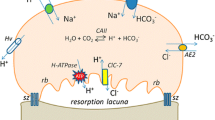Summary
We separated osteoclasts from bone and observed the effect of several known and potential mediators of the control of bone resorption on their cytoplasmic motility. We already found that calcitonin (CT), a hormone that inhibits bone resorption, regularly causes complete inhibition of cytoplasmic motility, specific for osteoclasts, through a trypsin-sensitive membrane receptor [1]. We report here that prostaglandin I2 (PGI2) and dibutyryl cyclic AMP induce an identical change in osteoclastic behavior. We found that theophylline, which inhibits intracellular cyclic AMP degradation, and which itself had no effect on osteoclastic motility, potentiated the cytoplasmic inhibition casued by CT, PGI2, and cyclic AMP. This suggests that PGI2 and CT cause cytoplasmic quiescence by increasing the intracellular level of cyclic AMP, a view compatible with the known ability of CT to increase cyclic AMP in bone [2]. Parathyroid hormone (PTH), PGE2, and 1,25 dihydroxycholecalciferol (1,25 (OH)2D3), hormones known to stimulate osteoclasts, did not stimulate the activity of either active or quiescent isolated osteoclasts. The undoubted ability of these hormones to stimulate osteoclastic activityin vivo may therefore be mediated through a primary hormonal interaction with another cell type.
Similar content being viewed by others
References
Chambers TJ, Magnus CJ (1982) Calcitonin alters behaviour of isolated osteoclasts. J Pathol 136:27–39
Murad F, Brewer HB, Vaughan M (1970) Effect of thyrocalcitonin on adenosine 3′:5′-cyclic monophosphate formation by rat kidney and bone. Proc Nat Acad Sci USA 65 446–453
Chambers TJ (1980) The cellular basis of bone resorption. Clinical Orthop Rel Res 151:283–293
Rodan GA, Martin TJ (1981) The role of osteoblasts in hormonal control of bone resorption. Calc Tissue Int 33:349–51
Bourne HR, Melmon KL (1971) J Pharmacol Exp Ther 178:1–7
Boyde A, Chambers TJ (in press) Scanning and transmission electron microscopic observations of osteoclasts in culture. In: Silbermann M, Slarkin H (eds) Proc of 5th Int Workshop on Calcif Tissues Excerpta Medica (Amsterdam)
Vaes G (1968) On the mechanisms of bone resorption. J Cell Biol 39:676–67
Scott BL, Pease DC (1956) Electron microscopy of the epiphyseal apparatus. Anat Rec 126:465–95
Austin LA, Heath LH (1981) Calcitonin. N Engl J Med 304:269–278
Warshawsky H, Goltman D, Roulean MF, Bergeron JJM (1981) Direct in vivo demonstration by autoradiography of specific binding sites for calcitonin in skeletal and renal tissues of the rat. J Cell Biol 85:682–694
Ali NN, Auger DW, Bennett A, Edwards DA, Harris M (1979) In: Vane, JR, Bergstrom S (eds) Prostacyclin Effect of prostacyclin and its breakdown products on bone resorption in vitro. Raven Press, New York, pp 179–185
Raisz LG, Vanderhoek JY, Simmons HA, Kream BE, Nicolaou KC (1979) Prostaglandin synthesis by foetal rat bone in vitro: evidence for a role of prostacyclin. Prostaglandins 17:905–912
Raisz LG, Au, WYW; Friedman J, Nieman I (1967) Thyrocalcitonin and bone resorption: studies using a tissue culture bioassay. Am J Med 43:684–690
Reynolds JJ, Dingle JT (1968) Time course of action of calcitonin on resorbing mouse bones in vitro. Nature 218:1179–9
Tashjian AH, Wright DR, Ivey JL, Pont A (1978) Calcium binding sties in bone: relationships to biological response and “escape.” Recent Progress in Hormone Research 34:285–332
Chambers TJ (in press) Osteoblasts release osteoclasts from calcitonin-induced immotility. J Cell Science
Author information
Authors and Affiliations
Rights and permissions
About this article
Cite this article
Chambers, T.J., Dunn, C.J. Pharmacological control of osteoclastic motility. Calcif Tissue Int 35, 566–570 (1983). https://doi.org/10.1007/BF02405095
Issue Date:
DOI: https://doi.org/10.1007/BF02405095




